Environmental Impact Assessment and Soft Tools
VerifiedAdded on 2023/06/07
|14
|4000
|411
AI Summary
This article discusses the Limits to Growth after Peak Oil and the steps and pitfalls of Environmental Impact Assessment (EIA). It also explores the concept of environmental offsets and their purpose and benefits in Western Australia. The article provides examples from Ethiopia and Turkey and suggests solutions to improve the EIA process. The subject matter is relevant to environmental studies and courses related to environmental impact assessment.
Contribute Materials
Your contribution can guide someone’s learning journey. Share your
documents today.
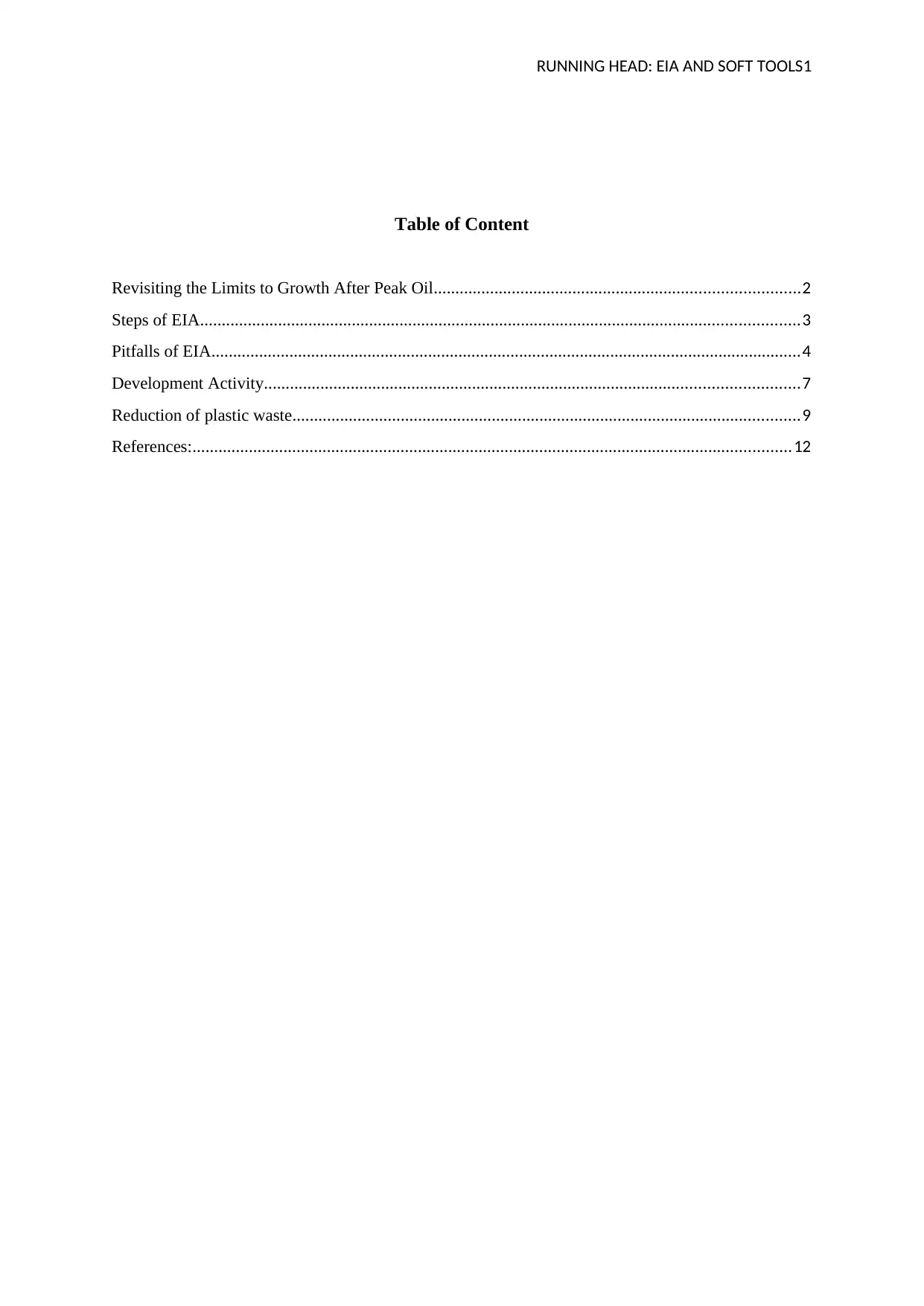
RUNNING HEAD: EIA AND SOFT TOOLS1
Table of Content
Revisiting the Limits to Growth After Peak Oil....................................................................................2
Steps of EIA..........................................................................................................................................3
Pitfalls of EIA........................................................................................................................................4
Development Activity...........................................................................................................................7
Reduction of plastic waste.....................................................................................................................9
References:..........................................................................................................................................12
Table of Content
Revisiting the Limits to Growth After Peak Oil....................................................................................2
Steps of EIA..........................................................................................................................................3
Pitfalls of EIA........................................................................................................................................4
Development Activity...........................................................................................................................7
Reduction of plastic waste.....................................................................................................................9
References:..........................................................................................................................................12
Secure Best Marks with AI Grader
Need help grading? Try our AI Grader for instant feedback on your assignments.
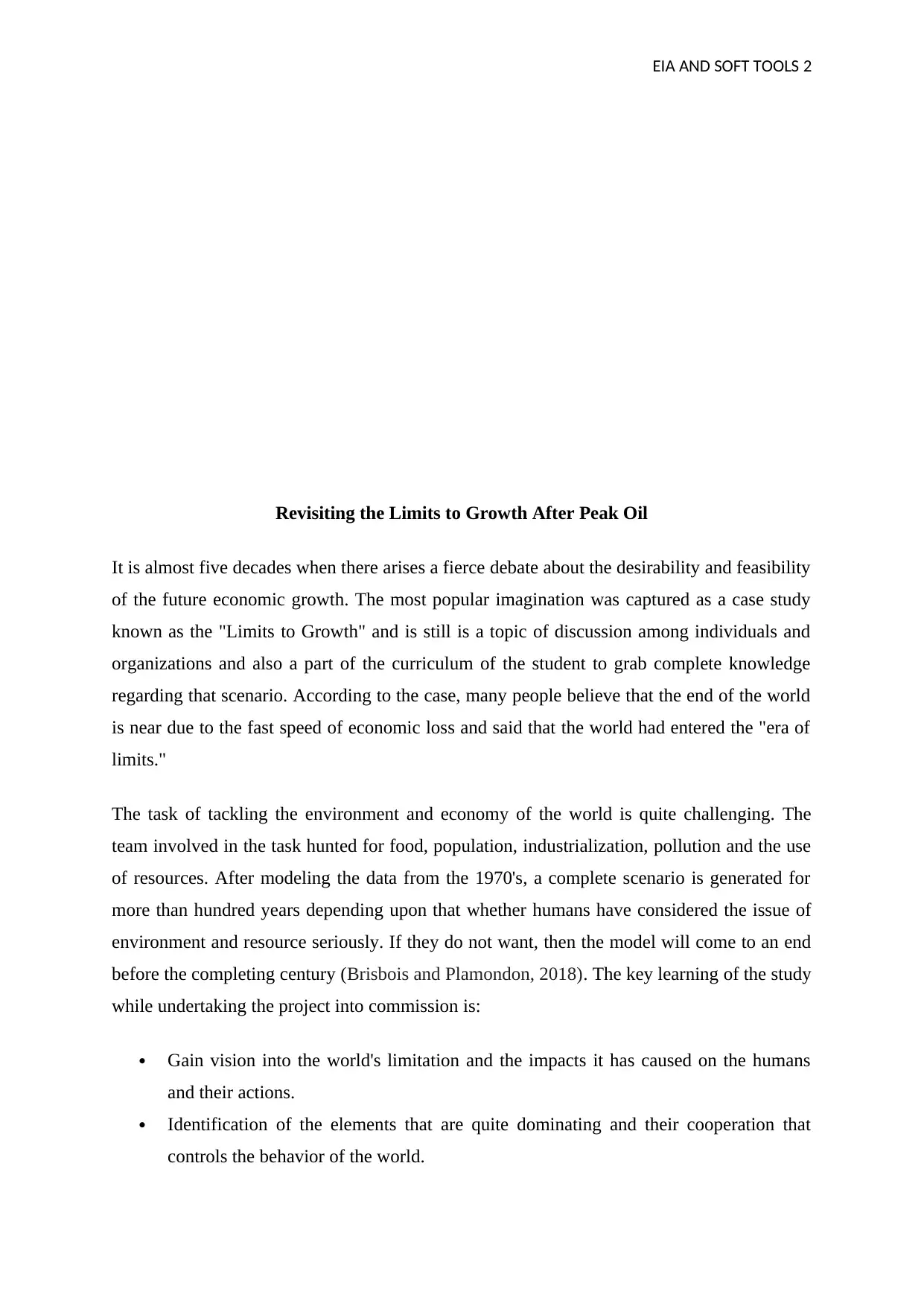
EIA AND SOFT TOOLS 2
Revisiting the Limits to Growth After Peak Oil
It is almost five decades when there arises a fierce debate about the desirability and feasibility
of the future economic growth. The most popular imagination was captured as a case study
known as the "Limits to Growth" and is still is a topic of discussion among individuals and
organizations and also a part of the curriculum of the student to grab complete knowledge
regarding that scenario. According to the case, many people believe that the end of the world
is near due to the fast speed of economic loss and said that the world had entered the "era of
limits."
The task of tackling the environment and economy of the world is quite challenging. The
team involved in the task hunted for food, population, industrialization, pollution and the use
of resources. After modeling the data from the 1970's, a complete scenario is generated for
more than hundred years depending upon that whether humans have considered the issue of
environment and resource seriously. If they do not want, then the model will come to an end
before the completing century (Brisbois and Plamondon, 2018). The key learning of the study
while undertaking the project into commission is:
Gain vision into the world's limitation and the impacts it has caused on the humans
and their actions.
Identification of the elements that are quite dominating and their cooperation that
controls the behavior of the world.
Revisiting the Limits to Growth After Peak Oil
It is almost five decades when there arises a fierce debate about the desirability and feasibility
of the future economic growth. The most popular imagination was captured as a case study
known as the "Limits to Growth" and is still is a topic of discussion among individuals and
organizations and also a part of the curriculum of the student to grab complete knowledge
regarding that scenario. According to the case, many people believe that the end of the world
is near due to the fast speed of economic loss and said that the world had entered the "era of
limits."
The task of tackling the environment and economy of the world is quite challenging. The
team involved in the task hunted for food, population, industrialization, pollution and the use
of resources. After modeling the data from the 1970's, a complete scenario is generated for
more than hundred years depending upon that whether humans have considered the issue of
environment and resource seriously. If they do not want, then the model will come to an end
before the completing century (Brisbois and Plamondon, 2018). The key learning of the study
while undertaking the project into commission is:
Gain vision into the world's limitation and the impacts it has caused on the humans
and their actions.
Identification of the elements that are quite dominating and their cooperation that
controls the behavior of the world.
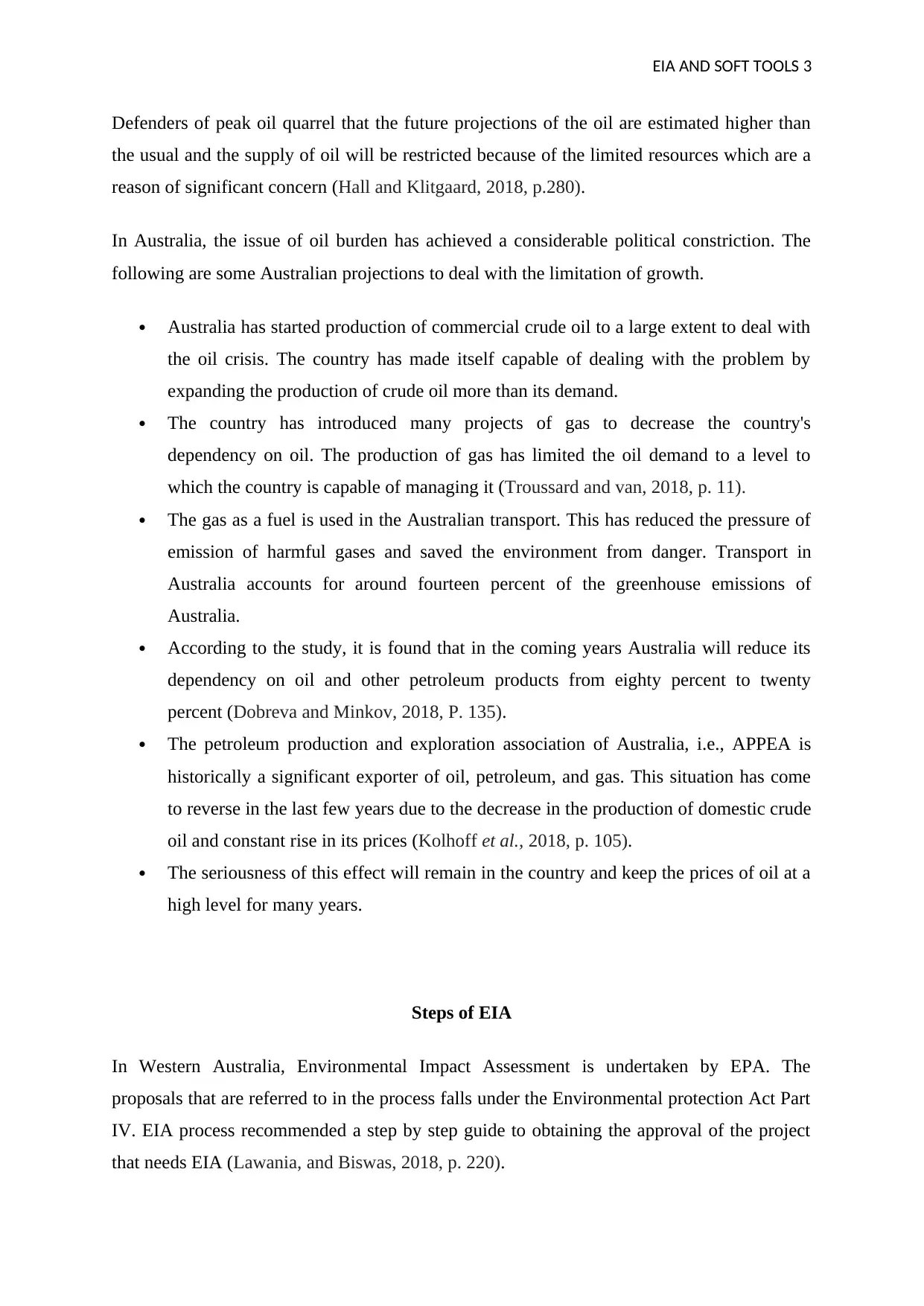
EIA AND SOFT TOOLS 3
Defenders of peak oil quarrel that the future projections of the oil are estimated higher than
the usual and the supply of oil will be restricted because of the limited resources which are a
reason of significant concern (Hall and Klitgaard, 2018, p.280).
In Australia, the issue of oil burden has achieved a considerable political constriction. The
following are some Australian projections to deal with the limitation of growth.
Australia has started production of commercial crude oil to a large extent to deal with
the oil crisis. The country has made itself capable of dealing with the problem by
expanding the production of crude oil more than its demand.
The country has introduced many projects of gas to decrease the country's
dependency on oil. The production of gas has limited the oil demand to a level to
which the country is capable of managing it (Troussard and van, 2018, p. 11).
The gas as a fuel is used in the Australian transport. This has reduced the pressure of
emission of harmful gases and saved the environment from danger. Transport in
Australia accounts for around fourteen percent of the greenhouse emissions of
Australia.
According to the study, it is found that in the coming years Australia will reduce its
dependency on oil and other petroleum products from eighty percent to twenty
percent (Dobreva and Minkov, 2018, P. 135).
The petroleum production and exploration association of Australia, i.e., APPEA is
historically a significant exporter of oil, petroleum, and gas. This situation has come
to reverse in the last few years due to the decrease in the production of domestic crude
oil and constant rise in its prices (Kolhoff et al., 2018, p. 105).
The seriousness of this effect will remain in the country and keep the prices of oil at a
high level for many years.
Steps of EIA
In Western Australia, Environmental Impact Assessment is undertaken by EPA. The
proposals that are referred to in the process falls under the Environmental protection Act Part
IV. EIA process recommended a step by step guide to obtaining the approval of the project
that needs EIA (Lawania, and Biswas, 2018, p. 220).
Defenders of peak oil quarrel that the future projections of the oil are estimated higher than
the usual and the supply of oil will be restricted because of the limited resources which are a
reason of significant concern (Hall and Klitgaard, 2018, p.280).
In Australia, the issue of oil burden has achieved a considerable political constriction. The
following are some Australian projections to deal with the limitation of growth.
Australia has started production of commercial crude oil to a large extent to deal with
the oil crisis. The country has made itself capable of dealing with the problem by
expanding the production of crude oil more than its demand.
The country has introduced many projects of gas to decrease the country's
dependency on oil. The production of gas has limited the oil demand to a level to
which the country is capable of managing it (Troussard and van, 2018, p. 11).
The gas as a fuel is used in the Australian transport. This has reduced the pressure of
emission of harmful gases and saved the environment from danger. Transport in
Australia accounts for around fourteen percent of the greenhouse emissions of
Australia.
According to the study, it is found that in the coming years Australia will reduce its
dependency on oil and other petroleum products from eighty percent to twenty
percent (Dobreva and Minkov, 2018, P. 135).
The petroleum production and exploration association of Australia, i.e., APPEA is
historically a significant exporter of oil, petroleum, and gas. This situation has come
to reverse in the last few years due to the decrease in the production of domestic crude
oil and constant rise in its prices (Kolhoff et al., 2018, p. 105).
The seriousness of this effect will remain in the country and keep the prices of oil at a
high level for many years.
Steps of EIA
In Western Australia, Environmental Impact Assessment is undertaken by EPA. The
proposals that are referred to in the process falls under the Environmental protection Act Part
IV. EIA process recommended a step by step guide to obtaining the approval of the project
that needs EIA (Lawania, and Biswas, 2018, p. 220).
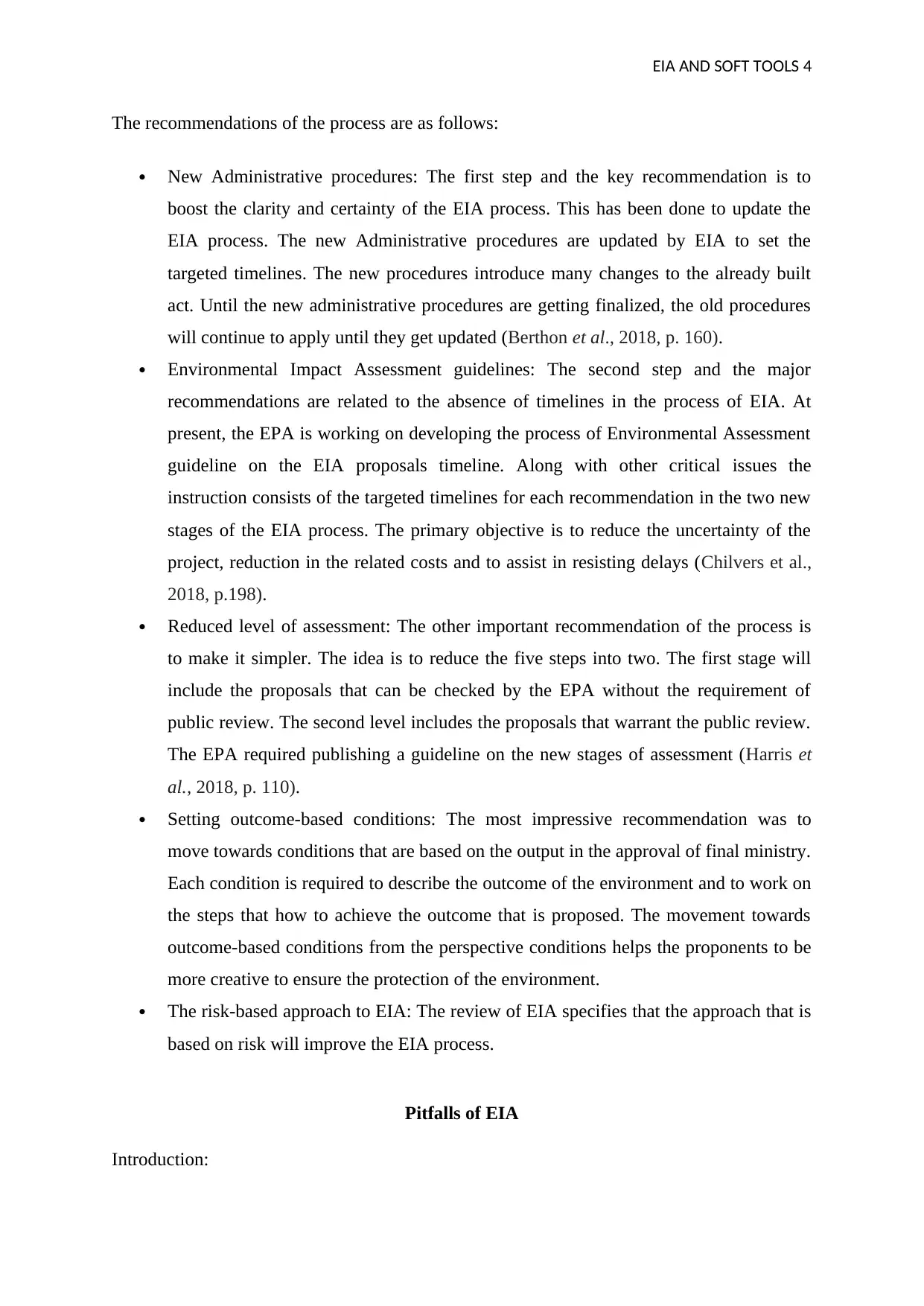
EIA AND SOFT TOOLS 4
The recommendations of the process are as follows:
New Administrative procedures: The first step and the key recommendation is to
boost the clarity and certainty of the EIA process. This has been done to update the
EIA process. The new Administrative procedures are updated by EIA to set the
targeted timelines. The new procedures introduce many changes to the already built
act. Until the new administrative procedures are getting finalized, the old procedures
will continue to apply until they get updated (Berthon et al., 2018, p. 160).
Environmental Impact Assessment guidelines: The second step and the major
recommendations are related to the absence of timelines in the process of EIA. At
present, the EPA is working on developing the process of Environmental Assessment
guideline on the EIA proposals timeline. Along with other critical issues the
instruction consists of the targeted timelines for each recommendation in the two new
stages of the EIA process. The primary objective is to reduce the uncertainty of the
project, reduction in the related costs and to assist in resisting delays (Chilvers et al.,
2018, p.198).
Reduced level of assessment: The other important recommendation of the process is
to make it simpler. The idea is to reduce the five steps into two. The first stage will
include the proposals that can be checked by the EPA without the requirement of
public review. The second level includes the proposals that warrant the public review.
The EPA required publishing a guideline on the new stages of assessment (Harris et
al., 2018, p. 110).
Setting outcome-based conditions: The most impressive recommendation was to
move towards conditions that are based on the output in the approval of final ministry.
Each condition is required to describe the outcome of the environment and to work on
the steps that how to achieve the outcome that is proposed. The movement towards
outcome-based conditions from the perspective conditions helps the proponents to be
more creative to ensure the protection of the environment.
The risk-based approach to EIA: The review of EIA specifies that the approach that is
based on risk will improve the EIA process.
Pitfalls of EIA
Introduction:
The recommendations of the process are as follows:
New Administrative procedures: The first step and the key recommendation is to
boost the clarity and certainty of the EIA process. This has been done to update the
EIA process. The new Administrative procedures are updated by EIA to set the
targeted timelines. The new procedures introduce many changes to the already built
act. Until the new administrative procedures are getting finalized, the old procedures
will continue to apply until they get updated (Berthon et al., 2018, p. 160).
Environmental Impact Assessment guidelines: The second step and the major
recommendations are related to the absence of timelines in the process of EIA. At
present, the EPA is working on developing the process of Environmental Assessment
guideline on the EIA proposals timeline. Along with other critical issues the
instruction consists of the targeted timelines for each recommendation in the two new
stages of the EIA process. The primary objective is to reduce the uncertainty of the
project, reduction in the related costs and to assist in resisting delays (Chilvers et al.,
2018, p.198).
Reduced level of assessment: The other important recommendation of the process is
to make it simpler. The idea is to reduce the five steps into two. The first stage will
include the proposals that can be checked by the EPA without the requirement of
public review. The second level includes the proposals that warrant the public review.
The EPA required publishing a guideline on the new stages of assessment (Harris et
al., 2018, p. 110).
Setting outcome-based conditions: The most impressive recommendation was to
move towards conditions that are based on the output in the approval of final ministry.
Each condition is required to describe the outcome of the environment and to work on
the steps that how to achieve the outcome that is proposed. The movement towards
outcome-based conditions from the perspective conditions helps the proponents to be
more creative to ensure the protection of the environment.
The risk-based approach to EIA: The review of EIA specifies that the approach that is
based on risk will improve the EIA process.
Pitfalls of EIA
Introduction:
Secure Best Marks with AI Grader
Need help grading? Try our AI Grader for instant feedback on your assignments.
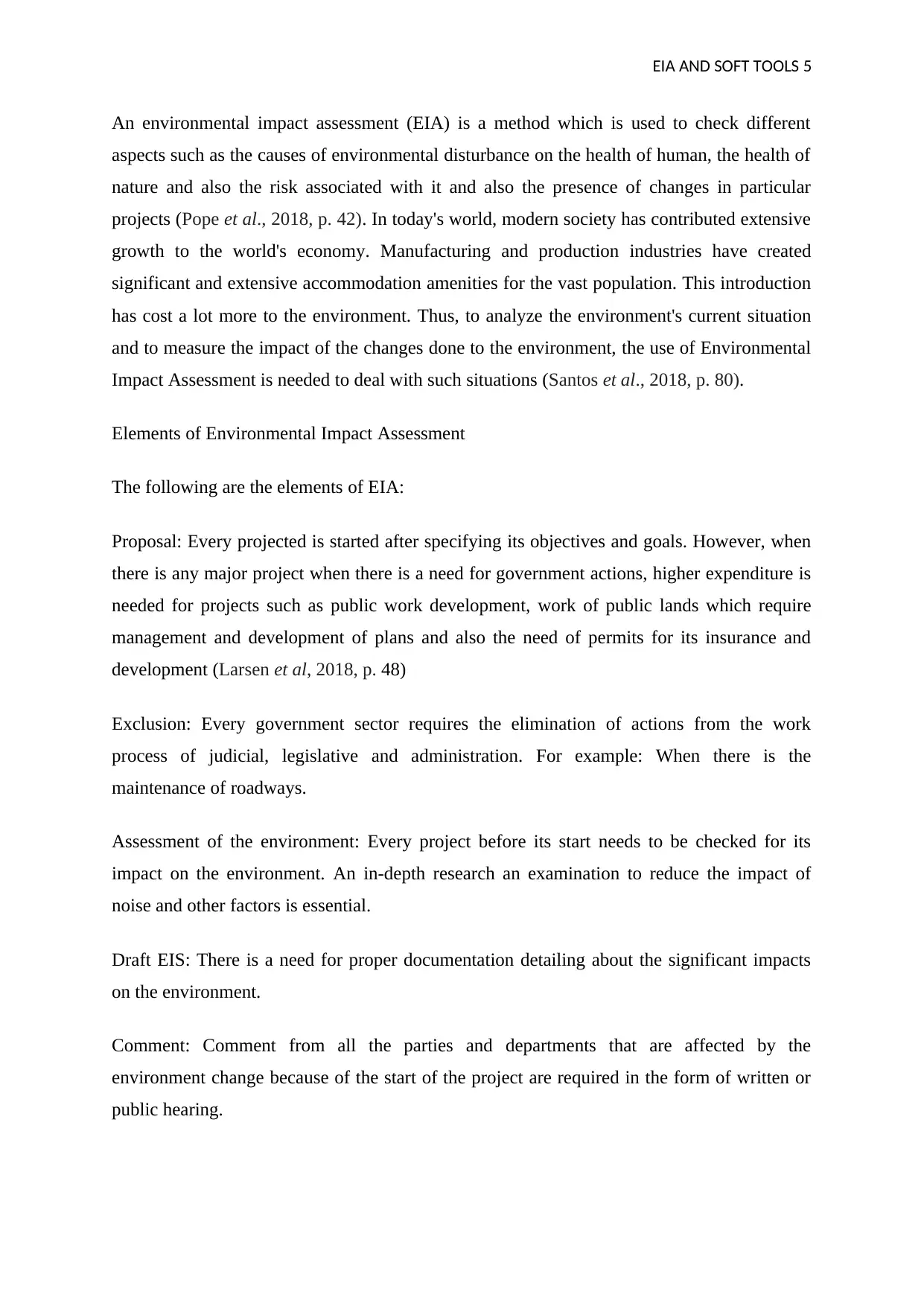
EIA AND SOFT TOOLS 5
An environmental impact assessment (EIA) is a method which is used to check different
aspects such as the causes of environmental disturbance on the health of human, the health of
nature and also the risk associated with it and also the presence of changes in particular
projects (Pope et al., 2018, p. 42). In today's world, modern society has contributed extensive
growth to the world's economy. Manufacturing and production industries have created
significant and extensive accommodation amenities for the vast population. This introduction
has cost a lot more to the environment. Thus, to analyze the environment's current situation
and to measure the impact of the changes done to the environment, the use of Environmental
Impact Assessment is needed to deal with such situations (Santos et al., 2018, p. 80).
Elements of Environmental Impact Assessment
The following are the elements of EIA:
Proposal: Every projected is started after specifying its objectives and goals. However, when
there is any major project when there is a need for government actions, higher expenditure is
needed for projects such as public work development, work of public lands which require
management and development of plans and also the need of permits for its insurance and
development (Larsen et al, 2018, p. 48)
Exclusion: Every government sector requires the elimination of actions from the work
process of judicial, legislative and administration. For example: When there is the
maintenance of roadways.
Assessment of the environment: Every project before its start needs to be checked for its
impact on the environment. An in-depth research an examination to reduce the impact of
noise and other factors is essential.
Draft EIS: There is a need for proper documentation detailing about the significant impacts
on the environment.
Comment: Comment from all the parties and departments that are affected by the
environment change because of the start of the project are required in the form of written or
public hearing.
An environmental impact assessment (EIA) is a method which is used to check different
aspects such as the causes of environmental disturbance on the health of human, the health of
nature and also the risk associated with it and also the presence of changes in particular
projects (Pope et al., 2018, p. 42). In today's world, modern society has contributed extensive
growth to the world's economy. Manufacturing and production industries have created
significant and extensive accommodation amenities for the vast population. This introduction
has cost a lot more to the environment. Thus, to analyze the environment's current situation
and to measure the impact of the changes done to the environment, the use of Environmental
Impact Assessment is needed to deal with such situations (Santos et al., 2018, p. 80).
Elements of Environmental Impact Assessment
The following are the elements of EIA:
Proposal: Every projected is started after specifying its objectives and goals. However, when
there is any major project when there is a need for government actions, higher expenditure is
needed for projects such as public work development, work of public lands which require
management and development of plans and also the need of permits for its insurance and
development (Larsen et al, 2018, p. 48)
Exclusion: Every government sector requires the elimination of actions from the work
process of judicial, legislative and administration. For example: When there is the
maintenance of roadways.
Assessment of the environment: Every project before its start needs to be checked for its
impact on the environment. An in-depth research an examination to reduce the impact of
noise and other factors is essential.
Draft EIS: There is a need for proper documentation detailing about the significant impacts
on the environment.
Comment: Comment from all the parties and departments that are affected by the
environment change because of the start of the project are required in the form of written or
public hearing.
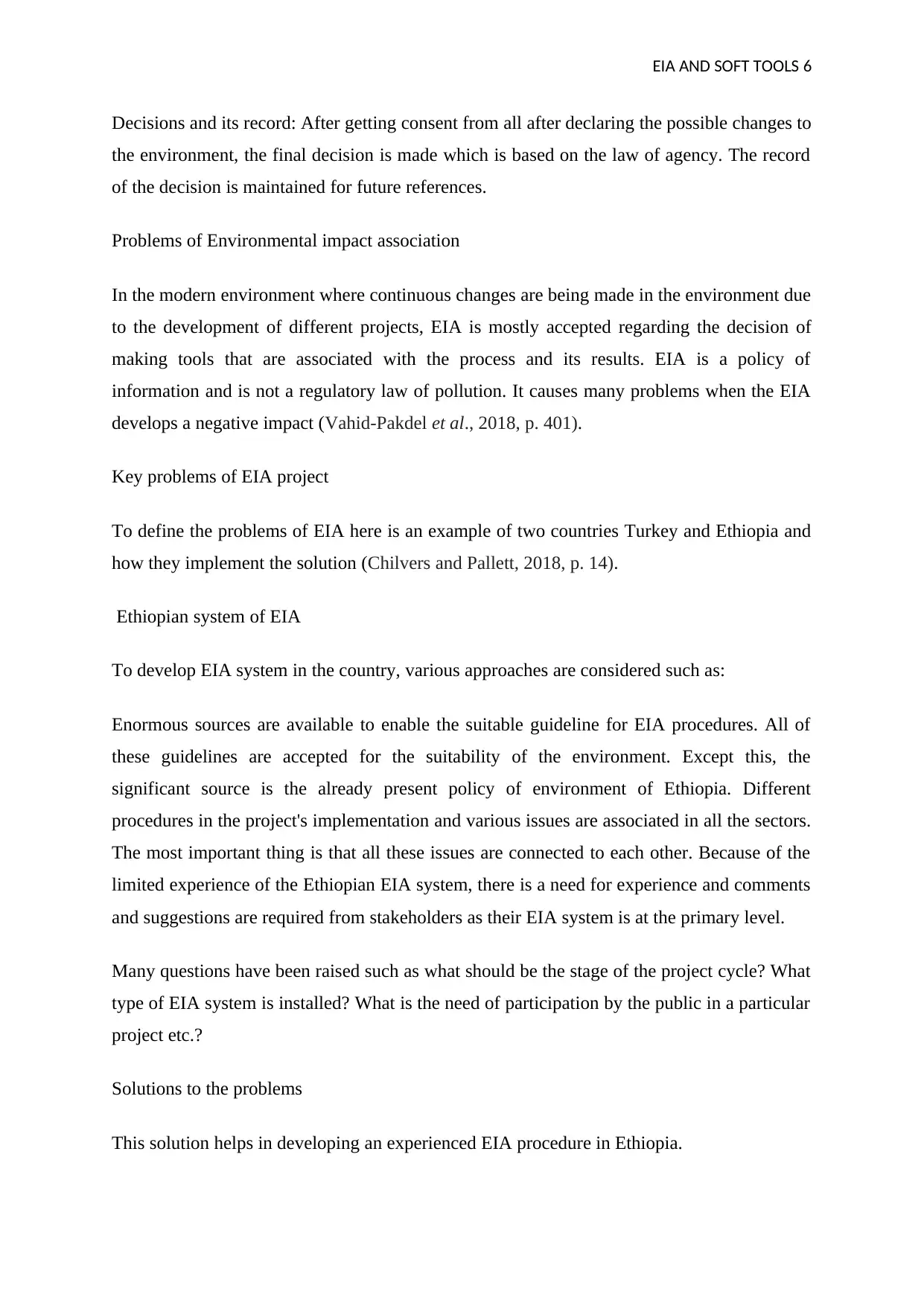
EIA AND SOFT TOOLS 6
Decisions and its record: After getting consent from all after declaring the possible changes to
the environment, the final decision is made which is based on the law of agency. The record
of the decision is maintained for future references.
Problems of Environmental impact association
In the modern environment where continuous changes are being made in the environment due
to the development of different projects, EIA is mostly accepted regarding the decision of
making tools that are associated with the process and its results. EIA is a policy of
information and is not a regulatory law of pollution. It causes many problems when the EIA
develops a negative impact (Vahid-Pakdel et al., 2018, p. 401).
Key problems of EIA project
To define the problems of EIA here is an example of two countries Turkey and Ethiopia and
how they implement the solution (Chilvers and Pallett, 2018, p. 14).
Ethiopian system of EIA
To develop EIA system in the country, various approaches are considered such as:
Enormous sources are available to enable the suitable guideline for EIA procedures. All of
these guidelines are accepted for the suitability of the environment. Except this, the
significant source is the already present policy of environment of Ethiopia. Different
procedures in the project's implementation and various issues are associated in all the sectors.
The most important thing is that all these issues are connected to each other. Because of the
limited experience of the Ethiopian EIA system, there is a need for experience and comments
and suggestions are required from stakeholders as their EIA system is at the primary level.
Many questions have been raised such as what should be the stage of the project cycle? What
type of EIA system is installed? What is the need of participation by the public in a particular
project etc.?
Solutions to the problems
This solution helps in developing an experienced EIA procedure in Ethiopia.
Decisions and its record: After getting consent from all after declaring the possible changes to
the environment, the final decision is made which is based on the law of agency. The record
of the decision is maintained for future references.
Problems of Environmental impact association
In the modern environment where continuous changes are being made in the environment due
to the development of different projects, EIA is mostly accepted regarding the decision of
making tools that are associated with the process and its results. EIA is a policy of
information and is not a regulatory law of pollution. It causes many problems when the EIA
develops a negative impact (Vahid-Pakdel et al., 2018, p. 401).
Key problems of EIA project
To define the problems of EIA here is an example of two countries Turkey and Ethiopia and
how they implement the solution (Chilvers and Pallett, 2018, p. 14).
Ethiopian system of EIA
To develop EIA system in the country, various approaches are considered such as:
Enormous sources are available to enable the suitable guideline for EIA procedures. All of
these guidelines are accepted for the suitability of the environment. Except this, the
significant source is the already present policy of environment of Ethiopia. Different
procedures in the project's implementation and various issues are associated in all the sectors.
The most important thing is that all these issues are connected to each other. Because of the
limited experience of the Ethiopian EIA system, there is a need for experience and comments
and suggestions are required from stakeholders as their EIA system is at the primary level.
Many questions have been raised such as what should be the stage of the project cycle? What
type of EIA system is installed? What is the need of participation by the public in a particular
project etc.?
Solutions to the problems
This solution helps in developing an experienced EIA procedure in Ethiopia.
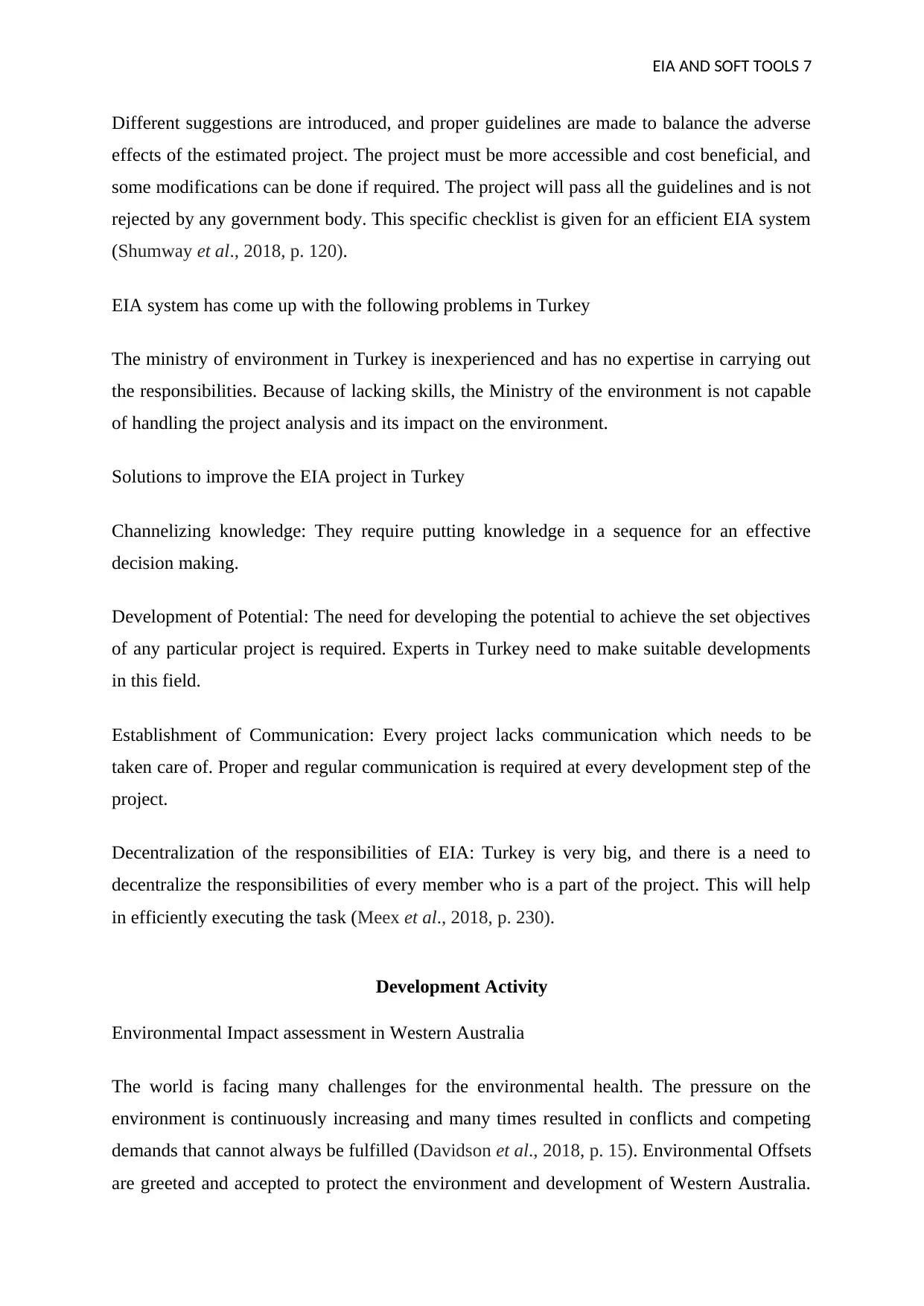
EIA AND SOFT TOOLS 7
Different suggestions are introduced, and proper guidelines are made to balance the adverse
effects of the estimated project. The project must be more accessible and cost beneficial, and
some modifications can be done if required. The project will pass all the guidelines and is not
rejected by any government body. This specific checklist is given for an efficient EIA system
(Shumway et al., 2018, p. 120).
EIA system has come up with the following problems in Turkey
The ministry of environment in Turkey is inexperienced and has no expertise in carrying out
the responsibilities. Because of lacking skills, the Ministry of the environment is not capable
of handling the project analysis and its impact on the environment.
Solutions to improve the EIA project in Turkey
Channelizing knowledge: They require putting knowledge in a sequence for an effective
decision making.
Development of Potential: The need for developing the potential to achieve the set objectives
of any particular project is required. Experts in Turkey need to make suitable developments
in this field.
Establishment of Communication: Every project lacks communication which needs to be
taken care of. Proper and regular communication is required at every development step of the
project.
Decentralization of the responsibilities of EIA: Turkey is very big, and there is a need to
decentralize the responsibilities of every member who is a part of the project. This will help
in efficiently executing the task (Meex et al., 2018, p. 230).
Development Activity
Environmental Impact assessment in Western Australia
The world is facing many challenges for the environmental health. The pressure on the
environment is continuously increasing and many times resulted in conflicts and competing
demands that cannot always be fulfilled (Davidson et al., 2018, p. 15). Environmental Offsets
are greeted and accepted to protect the environment and development of Western Australia.
Different suggestions are introduced, and proper guidelines are made to balance the adverse
effects of the estimated project. The project must be more accessible and cost beneficial, and
some modifications can be done if required. The project will pass all the guidelines and is not
rejected by any government body. This specific checklist is given for an efficient EIA system
(Shumway et al., 2018, p. 120).
EIA system has come up with the following problems in Turkey
The ministry of environment in Turkey is inexperienced and has no expertise in carrying out
the responsibilities. Because of lacking skills, the Ministry of the environment is not capable
of handling the project analysis and its impact on the environment.
Solutions to improve the EIA project in Turkey
Channelizing knowledge: They require putting knowledge in a sequence for an effective
decision making.
Development of Potential: The need for developing the potential to achieve the set objectives
of any particular project is required. Experts in Turkey need to make suitable developments
in this field.
Establishment of Communication: Every project lacks communication which needs to be
taken care of. Proper and regular communication is required at every development step of the
project.
Decentralization of the responsibilities of EIA: Turkey is very big, and there is a need to
decentralize the responsibilities of every member who is a part of the project. This will help
in efficiently executing the task (Meex et al., 2018, p. 230).
Development Activity
Environmental Impact assessment in Western Australia
The world is facing many challenges for the environmental health. The pressure on the
environment is continuously increasing and many times resulted in conflicts and competing
demands that cannot always be fulfilled (Davidson et al., 2018, p. 15). Environmental Offsets
are greeted and accepted to protect the environment and development of Western Australia.
Paraphrase This Document
Need a fresh take? Get an instant paraphrase of this document with our AI Paraphraser
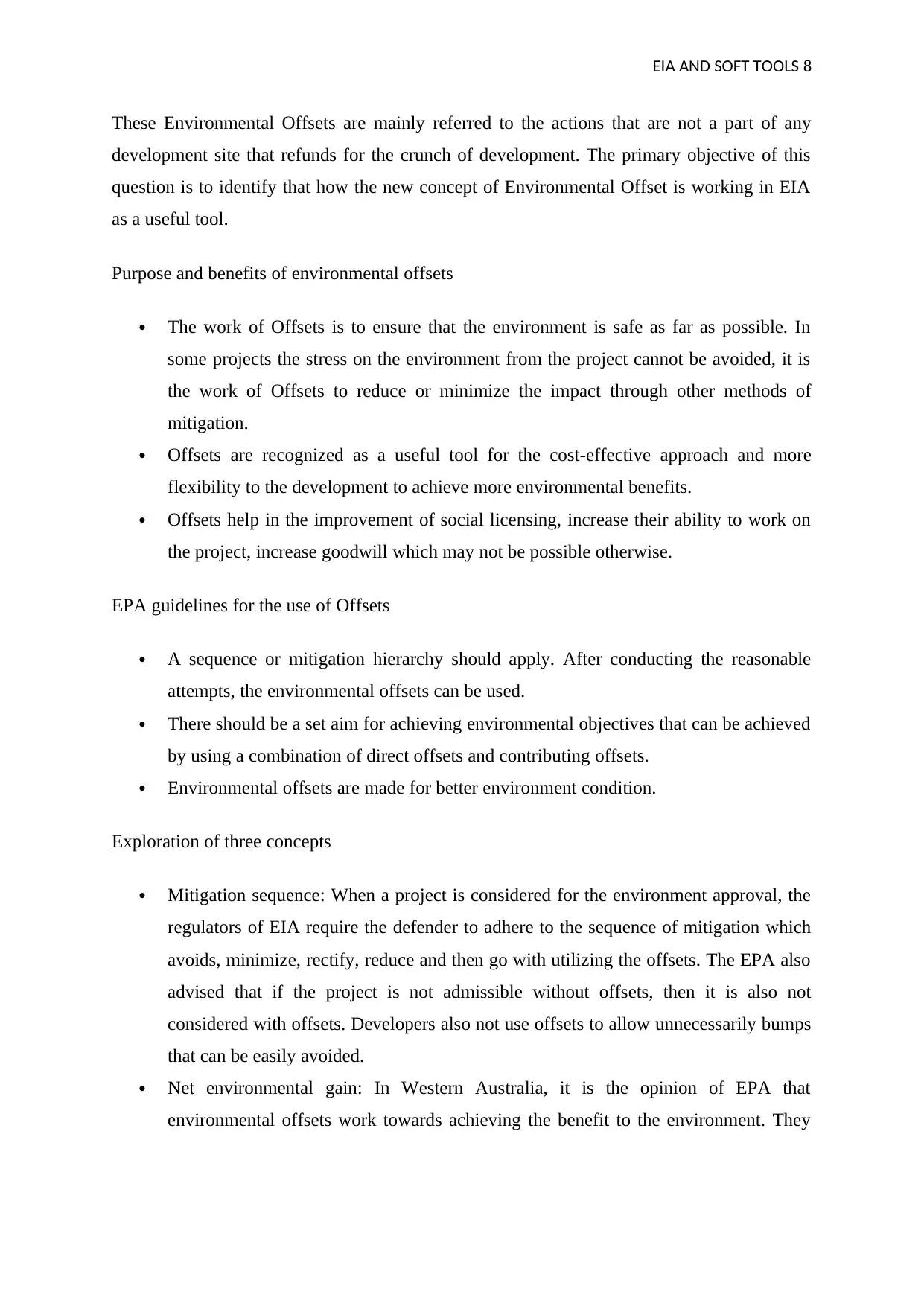
EIA AND SOFT TOOLS 8
These Environmental Offsets are mainly referred to the actions that are not a part of any
development site that refunds for the crunch of development. The primary objective of this
question is to identify that how the new concept of Environmental Offset is working in EIA
as a useful tool.
Purpose and benefits of environmental offsets
The work of Offsets is to ensure that the environment is safe as far as possible. In
some projects the stress on the environment from the project cannot be avoided, it is
the work of Offsets to reduce or minimize the impact through other methods of
mitigation.
Offsets are recognized as a useful tool for the cost-effective approach and more
flexibility to the development to achieve more environmental benefits.
Offsets help in the improvement of social licensing, increase their ability to work on
the project, increase goodwill which may not be possible otherwise.
EPA guidelines for the use of Offsets
A sequence or mitigation hierarchy should apply. After conducting the reasonable
attempts, the environmental offsets can be used.
There should be a set aim for achieving environmental objectives that can be achieved
by using a combination of direct offsets and contributing offsets.
Environmental offsets are made for better environment condition.
Exploration of three concepts
Mitigation sequence: When a project is considered for the environment approval, the
regulators of EIA require the defender to adhere to the sequence of mitigation which
avoids, minimize, rectify, reduce and then go with utilizing the offsets. The EPA also
advised that if the project is not admissible without offsets, then it is also not
considered with offsets. Developers also not use offsets to allow unnecessarily bumps
that can be easily avoided.
Net environmental gain: In Western Australia, it is the opinion of EPA that
environmental offsets work towards achieving the benefit to the environment. They
These Environmental Offsets are mainly referred to the actions that are not a part of any
development site that refunds for the crunch of development. The primary objective of this
question is to identify that how the new concept of Environmental Offset is working in EIA
as a useful tool.
Purpose and benefits of environmental offsets
The work of Offsets is to ensure that the environment is safe as far as possible. In
some projects the stress on the environment from the project cannot be avoided, it is
the work of Offsets to reduce or minimize the impact through other methods of
mitigation.
Offsets are recognized as a useful tool for the cost-effective approach and more
flexibility to the development to achieve more environmental benefits.
Offsets help in the improvement of social licensing, increase their ability to work on
the project, increase goodwill which may not be possible otherwise.
EPA guidelines for the use of Offsets
A sequence or mitigation hierarchy should apply. After conducting the reasonable
attempts, the environmental offsets can be used.
There should be a set aim for achieving environmental objectives that can be achieved
by using a combination of direct offsets and contributing offsets.
Environmental offsets are made for better environment condition.
Exploration of three concepts
Mitigation sequence: When a project is considered for the environment approval, the
regulators of EIA require the defender to adhere to the sequence of mitigation which
avoids, minimize, rectify, reduce and then go with utilizing the offsets. The EPA also
advised that if the project is not admissible without offsets, then it is also not
considered with offsets. Developers also not use offsets to allow unnecessarily bumps
that can be easily avoided.
Net environmental gain: In Western Australia, it is the opinion of EPA that
environmental offsets work towards achieving the benefit to the environment. They
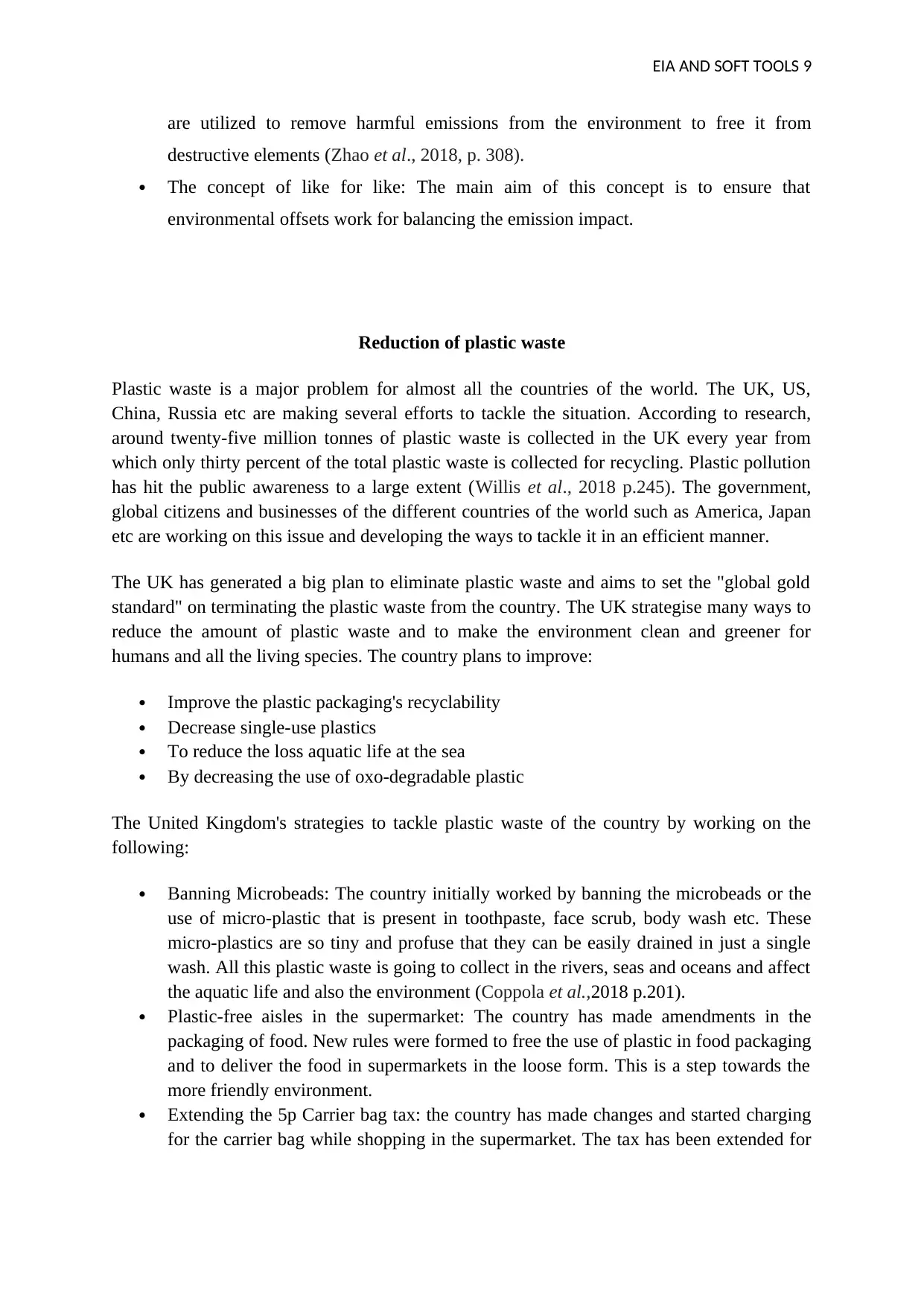
EIA AND SOFT TOOLS 9
are utilized to remove harmful emissions from the environment to free it from
destructive elements (Zhao et al., 2018, p. 308).
The concept of like for like: The main aim of this concept is to ensure that
environmental offsets work for balancing the emission impact.
Reduction of plastic waste
Plastic waste is a major problem for almost all the countries of the world. The UK, US,
China, Russia etc are making several efforts to tackle the situation. According to research,
around twenty-five million tonnes of plastic waste is collected in the UK every year from
which only thirty percent of the total plastic waste is collected for recycling. Plastic pollution
has hit the public awareness to a large extent (Willis et al., 2018 p.245). The government,
global citizens and businesses of the different countries of the world such as America, Japan
etc are working on this issue and developing the ways to tackle it in an efficient manner.
The UK has generated a big plan to eliminate plastic waste and aims to set the "global gold
standard" on terminating the plastic waste from the country. The UK strategise many ways to
reduce the amount of plastic waste and to make the environment clean and greener for
humans and all the living species. The country plans to improve:
Improve the plastic packaging's recyclability
Decrease single-use plastics
To reduce the loss aquatic life at the sea
By decreasing the use of oxo-degradable plastic
The United Kingdom's strategies to tackle plastic waste of the country by working on the
following:
Banning Microbeads: The country initially worked by banning the microbeads or the
use of micro-plastic that is present in toothpaste, face scrub, body wash etc. These
micro-plastics are so tiny and profuse that they can be easily drained in just a single
wash. All this plastic waste is going to collect in the rivers, seas and oceans and affect
the aquatic life and also the environment (Coppola et al.,2018 p.201).
Plastic-free aisles in the supermarket: The country has made amendments in the
packaging of food. New rules were formed to free the use of plastic in food packaging
and to deliver the food in supermarkets in the loose form. This is a step towards the
more friendly environment.
Extending the 5p Carrier bag tax: the country has made changes and started charging
for the carrier bag while shopping in the supermarket. The tax has been extended for
are utilized to remove harmful emissions from the environment to free it from
destructive elements (Zhao et al., 2018, p. 308).
The concept of like for like: The main aim of this concept is to ensure that
environmental offsets work for balancing the emission impact.
Reduction of plastic waste
Plastic waste is a major problem for almost all the countries of the world. The UK, US,
China, Russia etc are making several efforts to tackle the situation. According to research,
around twenty-five million tonnes of plastic waste is collected in the UK every year from
which only thirty percent of the total plastic waste is collected for recycling. Plastic pollution
has hit the public awareness to a large extent (Willis et al., 2018 p.245). The government,
global citizens and businesses of the different countries of the world such as America, Japan
etc are working on this issue and developing the ways to tackle it in an efficient manner.
The UK has generated a big plan to eliminate plastic waste and aims to set the "global gold
standard" on terminating the plastic waste from the country. The UK strategise many ways to
reduce the amount of plastic waste and to make the environment clean and greener for
humans and all the living species. The country plans to improve:
Improve the plastic packaging's recyclability
Decrease single-use plastics
To reduce the loss aquatic life at the sea
By decreasing the use of oxo-degradable plastic
The United Kingdom's strategies to tackle plastic waste of the country by working on the
following:
Banning Microbeads: The country initially worked by banning the microbeads or the
use of micro-plastic that is present in toothpaste, face scrub, body wash etc. These
micro-plastics are so tiny and profuse that they can be easily drained in just a single
wash. All this plastic waste is going to collect in the rivers, seas and oceans and affect
the aquatic life and also the environment (Coppola et al.,2018 p.201).
Plastic-free aisles in the supermarket: The country has made amendments in the
packaging of food. New rules were formed to free the use of plastic in food packaging
and to deliver the food in supermarkets in the loose form. This is a step towards the
more friendly environment.
Extending the 5p Carrier bag tax: the country has made changes and started charging
for the carrier bag while shopping in the supermarket. The tax has been extended for

EIA AND SOFT TOOLS 10
larger bags. This helps in reducing much plastic waste as many people started
carrying their own bag at shopping.
Banning cotton buds and straws: The country has banned cotton buds and straws to
save the marine environment as the most found plastic items near the oceans are
plastic straws.
The UK and other countries have taken many crucial steps to save the environment from
getting polluted by plastic waste.
larger bags. This helps in reducing much plastic waste as many people started
carrying their own bag at shopping.
Banning cotton buds and straws: The country has banned cotton buds and straws to
save the marine environment as the most found plastic items near the oceans are
plastic straws.
The UK and other countries have taken many crucial steps to save the environment from
getting polluted by plastic waste.
Secure Best Marks with AI Grader
Need help grading? Try our AI Grader for instant feedback on your assignments.

EIA AND SOFT TOOLS 11
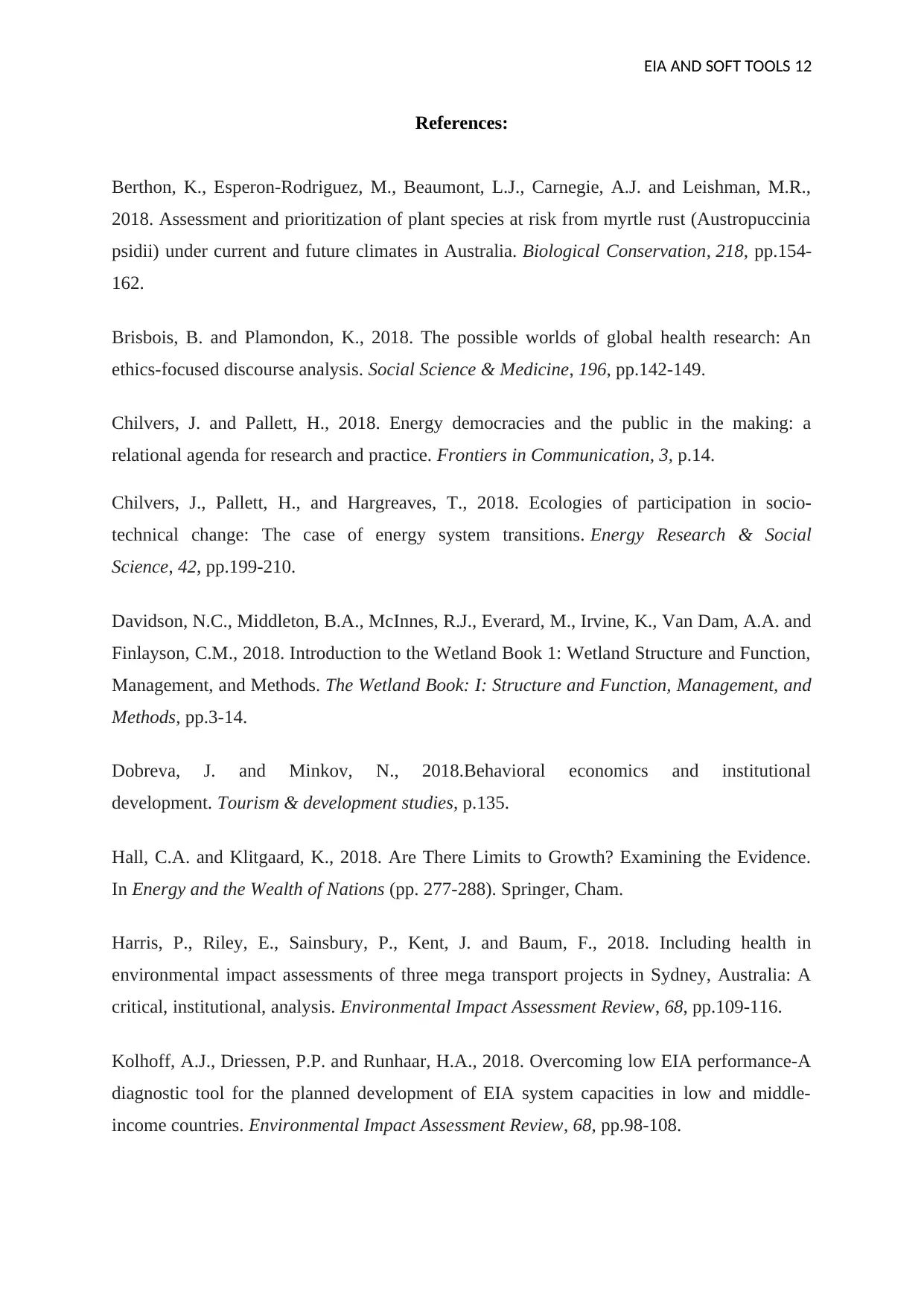
EIA AND SOFT TOOLS 12
References:
Berthon, K., Esperon-Rodriguez, M., Beaumont, L.J., Carnegie, A.J. and Leishman, M.R.,
2018. Assessment and prioritization of plant species at risk from myrtle rust (Austropuccinia
psidii) under current and future climates in Australia. Biological Conservation, 218, pp.154-
162.
Brisbois, B. and Plamondon, K., 2018. The possible worlds of global health research: An
ethics-focused discourse analysis. Social Science & Medicine, 196, pp.142-149.
Chilvers, J. and Pallett, H., 2018. Energy democracies and the public in the making: a
relational agenda for research and practice. Frontiers in Communication, 3, p.14.
Chilvers, J., Pallett, H., and Hargreaves, T., 2018. Ecologies of participation in socio-
technical change: The case of energy system transitions. Energy Research & Social
Science, 42, pp.199-210.
Davidson, N.C., Middleton, B.A., McInnes, R.J., Everard, M., Irvine, K., Van Dam, A.A. and
Finlayson, C.M., 2018. Introduction to the Wetland Book 1: Wetland Structure and Function,
Management, and Methods. The Wetland Book: I: Structure and Function, Management, and
Methods, pp.3-14.
Dobreva, J. and Minkov, N., 2018.Behavioral economics and institutional
development. Tourism & development studies, p.135.
Hall, C.A. and Klitgaard, K., 2018. Are There Limits to Growth? Examining the Evidence.
In Energy and the Wealth of Nations (pp. 277-288). Springer, Cham.
Harris, P., Riley, E., Sainsbury, P., Kent, J. and Baum, F., 2018. Including health in
environmental impact assessments of three mega transport projects in Sydney, Australia: A
critical, institutional, analysis. Environmental Impact Assessment Review, 68, pp.109-116.
Kolhoff, A.J., Driessen, P.P. and Runhaar, H.A., 2018. Overcoming low EIA performance-A
diagnostic tool for the planned development of EIA system capacities in low and middle-
income countries. Environmental Impact Assessment Review, 68, pp.98-108.
References:
Berthon, K., Esperon-Rodriguez, M., Beaumont, L.J., Carnegie, A.J. and Leishman, M.R.,
2018. Assessment and prioritization of plant species at risk from myrtle rust (Austropuccinia
psidii) under current and future climates in Australia. Biological Conservation, 218, pp.154-
162.
Brisbois, B. and Plamondon, K., 2018. The possible worlds of global health research: An
ethics-focused discourse analysis. Social Science & Medicine, 196, pp.142-149.
Chilvers, J. and Pallett, H., 2018. Energy democracies and the public in the making: a
relational agenda for research and practice. Frontiers in Communication, 3, p.14.
Chilvers, J., Pallett, H., and Hargreaves, T., 2018. Ecologies of participation in socio-
technical change: The case of energy system transitions. Energy Research & Social
Science, 42, pp.199-210.
Davidson, N.C., Middleton, B.A., McInnes, R.J., Everard, M., Irvine, K., Van Dam, A.A. and
Finlayson, C.M., 2018. Introduction to the Wetland Book 1: Wetland Structure and Function,
Management, and Methods. The Wetland Book: I: Structure and Function, Management, and
Methods, pp.3-14.
Dobreva, J. and Minkov, N., 2018.Behavioral economics and institutional
development. Tourism & development studies, p.135.
Hall, C.A. and Klitgaard, K., 2018. Are There Limits to Growth? Examining the Evidence.
In Energy and the Wealth of Nations (pp. 277-288). Springer, Cham.
Harris, P., Riley, E., Sainsbury, P., Kent, J. and Baum, F., 2018. Including health in
environmental impact assessments of three mega transport projects in Sydney, Australia: A
critical, institutional, analysis. Environmental Impact Assessment Review, 68, pp.109-116.
Kolhoff, A.J., Driessen, P.P. and Runhaar, H.A., 2018. Overcoming low EIA performance-A
diagnostic tool for the planned development of EIA system capacities in low and middle-
income countries. Environmental Impact Assessment Review, 68, pp.98-108.
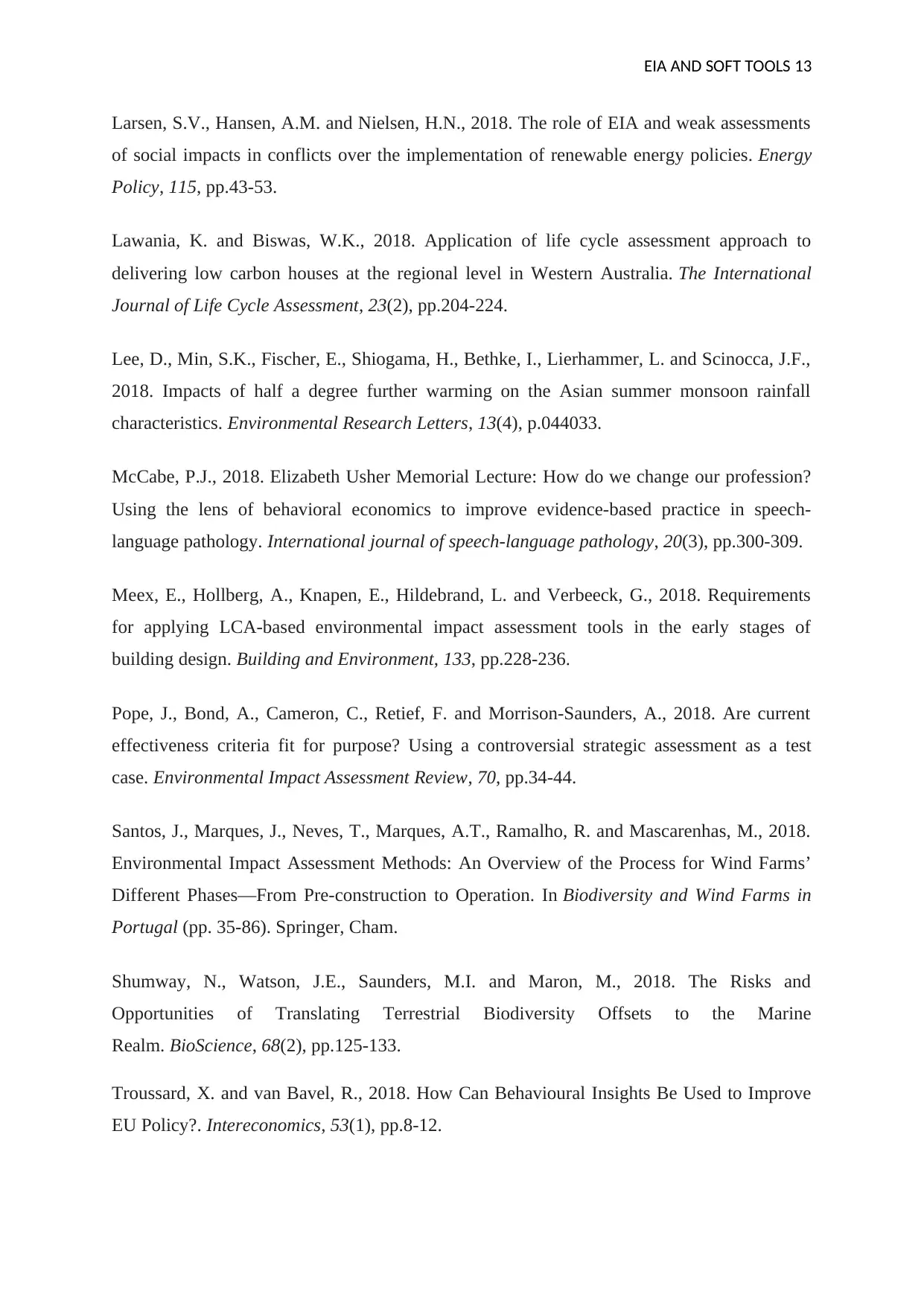
EIA AND SOFT TOOLS 13
Larsen, S.V., Hansen, A.M. and Nielsen, H.N., 2018. The role of EIA and weak assessments
of social impacts in conflicts over the implementation of renewable energy policies. Energy
Policy, 115, pp.43-53.
Lawania, K. and Biswas, W.K., 2018. Application of life cycle assessment approach to
delivering low carbon houses at the regional level in Western Australia. The International
Journal of Life Cycle Assessment, 23(2), pp.204-224.
Lee, D., Min, S.K., Fischer, E., Shiogama, H., Bethke, I., Lierhammer, L. and Scinocca, J.F.,
2018. Impacts of half a degree further warming on the Asian summer monsoon rainfall
characteristics. Environmental Research Letters, 13(4), p.044033.
McCabe, P.J., 2018. Elizabeth Usher Memorial Lecture: How do we change our profession?
Using the lens of behavioral economics to improve evidence-based practice in speech-
language pathology. International journal of speech-language pathology, 20(3), pp.300-309.
Meex, E., Hollberg, A., Knapen, E., Hildebrand, L. and Verbeeck, G., 2018. Requirements
for applying LCA-based environmental impact assessment tools in the early stages of
building design. Building and Environment, 133, pp.228-236.
Pope, J., Bond, A., Cameron, C., Retief, F. and Morrison-Saunders, A., 2018. Are current
effectiveness criteria fit for purpose? Using a controversial strategic assessment as a test
case. Environmental Impact Assessment Review, 70, pp.34-44.
Santos, J., Marques, J., Neves, T., Marques, A.T., Ramalho, R. and Mascarenhas, M., 2018.
Environmental Impact Assessment Methods: An Overview of the Process for Wind Farms’
Different Phases—From Pre-construction to Operation. In Biodiversity and Wind Farms in
Portugal (pp. 35-86). Springer, Cham.
Shumway, N., Watson, J.E., Saunders, M.I. and Maron, M., 2018. The Risks and
Opportunities of Translating Terrestrial Biodiversity Offsets to the Marine
Realm. BioScience, 68(2), pp.125-133.
Troussard, X. and van Bavel, R., 2018. How Can Behavioural Insights Be Used to Improve
EU Policy?. Intereconomics, 53(1), pp.8-12.
Larsen, S.V., Hansen, A.M. and Nielsen, H.N., 2018. The role of EIA and weak assessments
of social impacts in conflicts over the implementation of renewable energy policies. Energy
Policy, 115, pp.43-53.
Lawania, K. and Biswas, W.K., 2018. Application of life cycle assessment approach to
delivering low carbon houses at the regional level in Western Australia. The International
Journal of Life Cycle Assessment, 23(2), pp.204-224.
Lee, D., Min, S.K., Fischer, E., Shiogama, H., Bethke, I., Lierhammer, L. and Scinocca, J.F.,
2018. Impacts of half a degree further warming on the Asian summer monsoon rainfall
characteristics. Environmental Research Letters, 13(4), p.044033.
McCabe, P.J., 2018. Elizabeth Usher Memorial Lecture: How do we change our profession?
Using the lens of behavioral economics to improve evidence-based practice in speech-
language pathology. International journal of speech-language pathology, 20(3), pp.300-309.
Meex, E., Hollberg, A., Knapen, E., Hildebrand, L. and Verbeeck, G., 2018. Requirements
for applying LCA-based environmental impact assessment tools in the early stages of
building design. Building and Environment, 133, pp.228-236.
Pope, J., Bond, A., Cameron, C., Retief, F. and Morrison-Saunders, A., 2018. Are current
effectiveness criteria fit for purpose? Using a controversial strategic assessment as a test
case. Environmental Impact Assessment Review, 70, pp.34-44.
Santos, J., Marques, J., Neves, T., Marques, A.T., Ramalho, R. and Mascarenhas, M., 2018.
Environmental Impact Assessment Methods: An Overview of the Process for Wind Farms’
Different Phases—From Pre-construction to Operation. In Biodiversity and Wind Farms in
Portugal (pp. 35-86). Springer, Cham.
Shumway, N., Watson, J.E., Saunders, M.I. and Maron, M., 2018. The Risks and
Opportunities of Translating Terrestrial Biodiversity Offsets to the Marine
Realm. BioScience, 68(2), pp.125-133.
Troussard, X. and van Bavel, R., 2018. How Can Behavioural Insights Be Used to Improve
EU Policy?. Intereconomics, 53(1), pp.8-12.
Paraphrase This Document
Need a fresh take? Get an instant paraphrase of this document with our AI Paraphraser

EIA AND SOFT TOOLS 14
Coppola, B., Courard, L., Michel, F., Incarnato, L., Scarfato, P. and Di Maio, L., 2018.
Hygro-thermal and durability properties of a lightweight mortar made with foamed plastic
waste aggregates. Construction and Building Materials, 170, pp.200-206.
Willis, K., Maureaud, C., Wilcox, C. and Hardesty, B.D., 2018. How successful are waste
abatement campaigns and government policies at reducing plastic waste into the marine
environment?. Marine Policy, 96, pp.243-249.
Coppola, B., Courard, L., Michel, F., Incarnato, L., Scarfato, P. and Di Maio, L., 2018.
Hygro-thermal and durability properties of a lightweight mortar made with foamed plastic
waste aggregates. Construction and Building Materials, 170, pp.200-206.
Willis, K., Maureaud, C., Wilcox, C. and Hardesty, B.D., 2018. How successful are waste
abatement campaigns and government policies at reducing plastic waste into the marine
environment?. Marine Policy, 96, pp.243-249.
1 out of 14
Related Documents
Your All-in-One AI-Powered Toolkit for Academic Success.
+13062052269
info@desklib.com
Available 24*7 on WhatsApp / Email
![[object Object]](/_next/static/media/star-bottom.7253800d.svg)
Unlock your academic potential
© 2024 | Zucol Services PVT LTD | All rights reserved.




